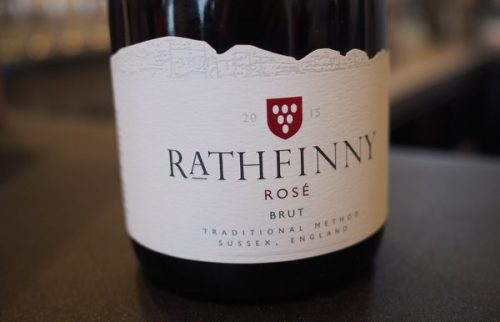
Today, after lots of anticipation, the first sparkling wines from Rathfinny were launched. It’s an ambitious project, and one that has been much talked about, and so it was great to finally get to taste these wines. The long and short of it is that they are very good, and this sizeable estate is a very welcome addition to the English and Welsh wine scene. We need more top quality, professional, ambitious players, and if Rathfinny’s subsequent releases are as good as these first ones, they are playing at the top end, along with the likes of Nyetimber, Hambledon, Ridgeview and Gusbourne.

The first vines were planted here in 2012, and the original plantings were all with high grafts, which helped things along a bit. The first crop was in 2014, and was around 15 tons. Last vintage some 200 tons were harvested, and that looks set to increase in 2018.
The soils are all chalk with varying depths of top soil, ranging from 30 cm at the top and 50 cm at the bottom. They are very free draining, and although they aren’t managed organically, they are treated sympathetically. There’s some herbicide use under the rows, but some of the under vine areas are managed manually. The wind is the main viticultural challenge, but this also has the side-benefit of keeping the vineyard relatively disease free.

Harvest is as late as possible, to get full flavour maturity. There’s no problem with acidity. The 2014 was picked in the last week of October, for example, just before the leaves fell off. ‘The revelation here is Pinot Meunier,’ says owner Mark Driver. ‘It’s 10%, but we are planting more. If you ripen it, it has great aromatics and balance of flavours.’
Future releases will be a Blanc de Noirs next year, and then the following year a classic cuvée blend that initially will be vintage, but then may go non-vintage in the future. These two initial wines will be sold through Gonzalez Byass, and 90% will go to high-end on-trade, beginning with a month exclusivity to the Savoy. Retail will be c. £35.
Rathfinny Blanc de Blancs 2014 Sussex, England
Dosage 4 g/litre. Very precise and delicate. Pure and linear with clean, crisp fruit. Refined and pure showing some pear, citrus and white peach fruit with incredible delicacy. The acid is so well integrated into the wine it doesn’t stick out at all. Lovely elegance and precision here: spot on for the first release. 93/100
Rathfinny Rosé 2015 Sussex, England
2.5 g/l dosage. 50% Pinot Noir, 40% Chardonnay, 10% Pinot Meunier. Red wine is Pinot Noir Precoce, aged in barrels. Pale pink colour. Delicate and focused with nice crisp citrus fruit as well as faint hints of strawberry and red cherry. Has lovely focus and purity with good acidity. Tight and quite fine with nice grip. A really assured, composed wine. 92/100
Glad the wines are good. Any chance you could you explain this bit “and the original plantings were all with high grafts, which helped things along a bit”
You can buy vines from nurseries that have longer scions, so when they are planted they are immediately taller. They have more wood, so more carbohydrate reserves, and they get going quicker.
Ahh interesting, thanks!
No they don’t have longer scions – they have longer rootstocks. These create an instant trunk and thus (in theory) save a year. As for the bit about carbohydrates – I have never heard that before! The high-graft vines didnt work 100% in Rathfinny’s case as the vines took longer to establish owing to the wind. The longer rootstocks don’t have shoots which appear in the spring which, with ‘low graft’ vines, have to be rubbed off every year, but do cost twice as much. I don’t think that Rathfinny are using them for their later plantings. (Might be wrong there).
thanks for the clarification
Oh Steven, you always seem to have a downer on Rathfinny!! More English vineyards should use high-grafted vines. Our rootstocks are 90cm high, which gets you straight onto the ‘fruiting wire’ and they’re ideal for high trellising systems (VSP) adopted by the majority of vineyards in the new world. We had a higher than normal failure rate (2%) in our first years planting due to the exceptionally cold and wet summer of 2012, then the exceptionally dry summer of 2013. But all subsequent plantings have seen normal <1% failure rates. Also, high grafted vines save you money, as you don’t need to do any ‘bud rubbing’ (the removal of water shoots on the trunk in the first few years) and we got a small crop off our vines in year three 2014! They might cost more initially but they save you time and money training a cane up to fruiting wire as needed with ‘old fashioned’ low grafted vines. Last year, we planted some low grafted vines, partly because we couldn’t get enough Fercal rootstock for the nursery to make the high grafts, and partly as insurance, because if you get a severe infection of trunk disease you can only cut back to the graft union and we’re insuring ourselves against trunk disease risk. With regards to wind. We’re on a perfect site, but we’re close to the sea so we needed to protect the vines from sea breezes. If you visit Tasmania or the Margaret River you’ll notice that they planted wine breaks to help shield the vines from sea breezes, we’ve done exactly the same. The benefit of our location is that we have very low disease risk as the breeze helps remove the moisture from the vines and we haven’t been affected by late spring frosts. You haven’t been down for a few years, why don’t you come and visit.